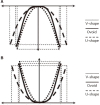Analysis of dimensions and shapes of maxillary and mandibular dental arch in Korean young adults
- PMID: 29142638
- PMCID: PMC5673607
- DOI: 10.4047/jap.2017.9.5.321
Analysis of dimensions and shapes of maxillary and mandibular dental arch in Korean young adults
Abstract
Purpose: The aim of this study was to investigate dental arch dimensions and to classify arch shape in Korean young adults.
Materials and methods: The sample included 50 Koreans with age ranging from 24 to 32 years. Maxillary and mandibular casts were fabricated using irreversible hydrocolloid and type III dental stones. Incisor-canine distance, incisor-1st molar distance, incisor-2nd molar distance, intercanine distance, inter-1st molar distance, and inter-2nd molar distance in both the maxillary and mandibular arch were measured using a three-dimensional measuring device. The dental arch was classified into three groups using five ratios from the measured values by the K-means clustering method. The data were analyzed with one-way analysis of variance.
Results: Arch lengths (IM2D, incisal-2nd molar distance) were 44.13 mm in the maxilla and 40.40 mm in the mandible. Arch widths (M2W, inter 2nd molar width) were 64.12 mm in the maxilla and 56.37 mm in the mandible. Distribution of the dental arch form was mostly ovoid shape (maxilla 52% and mandible 56%), followed by the V-shape and the U-shape. The arch width for the U-shape was broader than for the other forms.
Conclusion: This study establishes new reference data for dental arch dimensions for young Korean adults. The most common arch form is the ovoid type in the maxilla and mandible of Koreans. Clinicians should be aware of these references and classify arch type before and during their dental treatment for effective and harmonized results in Koreans.
Keywords: Dental arch dimension; Dental arch form; Dental arch shape; Korean adult.
Figures






References
-
- Smith SS, Buschang PH, Watanabe E. Interarch tooth size relationships of 3 populations: “does Bolton’s analysis apply?”. Am J Orthod Dentofacial Orthop. 2000;117:169–174. - PubMed
-
- Al-Khateeb SN, Abu Alhaija ES. Tooth size discrepancies and arch parameters among different malocclusions in a Jordanian sample. Angle Orthod. 2006;76:459–465. - PubMed
-
- Ferrario VF, Sforza C, Colombo A, Carvajal R, Duncan V, Palomino H. Dental arch size in healthy human permanent dentitions: ethnic differences as assessed by discriminant analysis. Int J Adult Orthodon Orthognath Surg. 1999;14:153–162. - PubMed
-
- Dalidjan M, Sampson W, Townsend G. Prediction of dental arch development: an assessment of Pont's Index in three human populations. Am J Orthod Dentofacial Orthop. 1995;107:465–475. - PubMed
-
- Hassanali J, Pokhariyal GP. Anterior tooth relations in Kenyan Africans. Arch Oral Biol. 1993;38:337–342. - PubMed
LinkOut - more resources
Full Text Sources
Other Literature Sources

